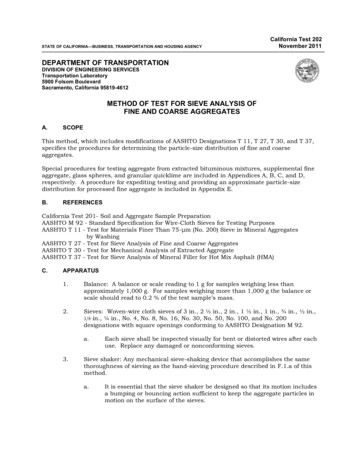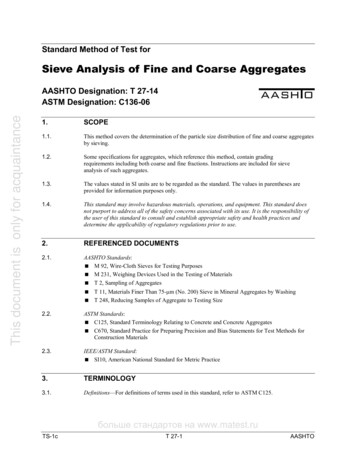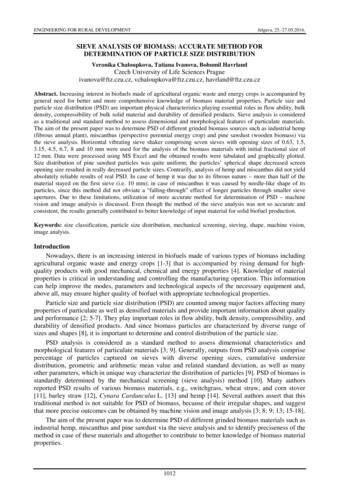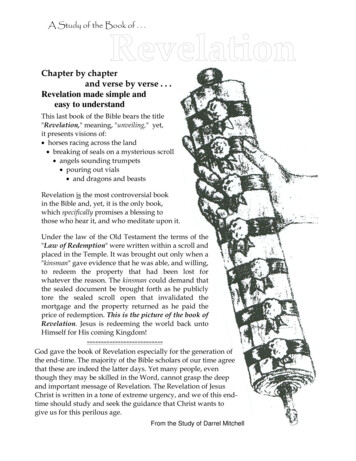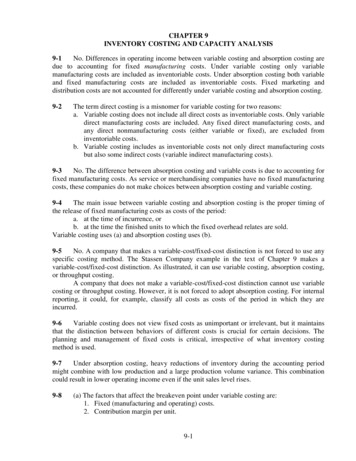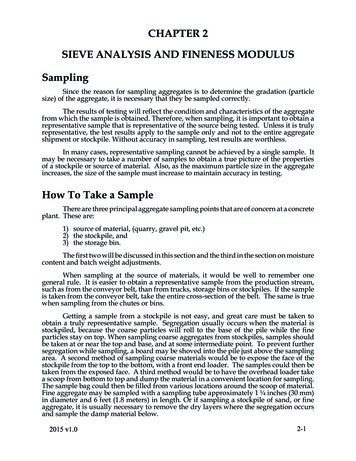
Transcription
CHAPTER 2SIEVE ANALYSIS AND FINENESS MODULUSSamplingSince the reason for sampling aggregates is to determine the gradation (particlesize) of the aggregate, it is necessary that they be sampled correctly.The results of testing will re"ect the condition and characteristics of the aggregatefrom which the sample is obtained. Therefore, when sampling, it is important to obtain arepresentative sample that is representative of the source being tested. Unless it is trulyrepresentative, the test results apply to the sample only and not to the entire aggregateshipment or stockpile. Without accuracy in sampling, test results are worthless.In many cases, representative sampling cannot be achieved by a single sample. Itmay be necessary to take a number of samples to obtain a true picture of the propertiesof a stockpile or source of material. Also, as the maximum particle size in the aggregateincreases, the size of the sample must increase to maintain accuracy in testing.How To Take a SampleThere are three principal aggregate sampling points that are of concern at a concreteplant. These are:1) source of material, (quarry, gravel pit, etc.)2) the stockpile, and3) the storage bin.The !rst two will be discussed in this section and the third in the section on moisturecontent and batch weight adjustments.When sampling at the source of materials, it would be well to remember onegeneral rule. It is easier to obtain a representative sample from the production stream,such as from the conveyor belt, than from trucks, storage bins or stockpiles. If the sampleis taken from the conveyor belt, take the entire cross-section of the belt. The same is truewhen sampling from the chutes or bins.Getting a sample from a stockpile is not easy, and great care must be taken toobtain a truly representative sample. Segregation usually occurs when the material isstockpiled, because the coarse particles will roll to the base of the pile while the !neparticles stay on top. When sampling coarse aggregates from stockpiles, samples shouldbe taken at or near the top and base, and at some intermediate point. To prevent furthersegregation while sampling, a board may be shoved into the pile just above the samplingarea. A second method of sampling coarse materials would be to expose the face of thestockpile from the top to the bottom, with a front end loader. The samples could then betaken from the exposed face. A third method would be to have the overhead loader takea scoop from bottom to top and dump the material in a convenient location for sampling.The sample bag could then be !lled from various locations around the scoop of material.Fine aggregate may be sampled with a sampling tube approximately 1 ¼ inches (30 mm)in diameter and 6 feet (1.8 meters) in length. Or if sampling a stockpile of sand, or !neaggregate, it is usually necessary to remove the dry layers where the segregation occursand sample the damp material below.!#" %"&#"
Sieve AnalysisAggregate gradation (sieve analysis) is the distribution of particle sizes expressedas a percent of the total dry weight. Gradation is determined by passing the materialthrough a series of sieves stacked with progressively smaller openings from top to bottomand weighing the material retained on each sieve. Sieve numbers and sizes most oftenused in grading aggregates for Hydraulic Concrete paving mixtures are as follows:!"# %#&"
Nominal Dimensions of U.S.Standard Sieves - AASHTO M 92Nominal sieveOpeningsSieve DesignationmetricstandardMetricinches50.0 mm250.0 mm2.0037.5 mm1½37.5 mm1.5025.0 mm125.0 mm1.0019.0 mm3/419.0 mm0.75012.5 mm1/212.5 mm0.5009.5 mm3/89.5 mm0.3754.75 mmNo. 44.75 mm0.1872.36 mmNo. 82.36 mm0.0931.18 mmNo. 161.18 mm0.0469600 µmNo. 300.600 mm0.0234300 µmNo. 500.300 mm0.0117150 µmNo. 1000.150 mm0.005975 µmNo. 2000.075 mm0.0029Sieve sizes to be used for the various mixtures are designated in the Road andBridge Speci!cations. Gradations are expressed on the basis of total percent dry weightpassing, which indicates the total percent of aggregate by weight that will pass a givensize sieve.Some of the descriptive terms used in referring to aggregate gradations are:Coarse Aggregate: All the materials retained on and above the No. 8 (2.36 mm) sieveFine Aggregate: All the material passing the No. 8 (2.36 mm) sieve.!# %& '#"
Procedure For Sieve AnalysisDry sieve analysis and washed sieve analysis are two methods of determiningproportions of various particle sizes in a mineral aggregate. In Virginia, however, theWASHED SIEVE ANALYSIS is used, and will be discussed in this section. Standardprocedures for running the sieve analysis are given in AASHTO T 27 and AASHTO T11.Regardless of the size of the aggregate, the procedure for running a sieve analysisis basically the same. The steps for this procedure are outlined as follows:Obtain a representative sample of the material from the original sample by either asample splitter or the quartering method. (See paragraphs a and b below.) Reduceto a size that can be handled on the balance and sieves, also, according to maximumstone size. Reference AASHTO T 27.1.!a.Sample Splitter - Sample splitters shall have even number of equal width chutes,but not less than a total of eight for coarse aggregates, or twelve for !ne aggregates,which discharge alternately to each side of the splitter. The splitter shall beequipped with two receptacles to hold the two halves of the sample followingsplitting. It shall be equipped with a hopper or straightedge pan which has awidth of the assembly of chutes, by which the sample may be fed at a controlledrate to the chutes. The splitter and accessory equipment shall be so designedthat the sample will "ow smoothly without restriction or loss of material. Placethe !eld sample in the hopper or pan and uniformly distribute it from edge toedge, so that when it is introduced into the chutes, approximately equal amountswill "ow through each chute. The rate at which the sample is introduced shallbe such as to allow free "owing through the chutes into the receptacles below.Reintroduce the portion of the sample in one of the receptacles into the splitteras many times as necessary to reduce the sample to the size speci!ed for theintended test. The portion of the material collected in the other receptacle maybe reserved for reduction in size for other tests.b.Quartering Method - The following method for size reduction by quartering isoutlined for use when a conventional sample splitter is not available.1.Distribute a shovel full of the aggregate as uniformly as possible over awide, "at area on a tight weave canvas or other smooth surface. Continueto distribute shovels full of material in layers until all the sample is usedto make a wide, "at pile that is reasonably uniform in thickness anddiameter. Do not permit coning of the aggregate.2.Divide the pile cleanly into equal quarters with a square-ended shovelor straight piece of sheet metal. When a canvas is used, the division maybe conveniently made by inserting a thin stick (or rod) under the canvasand raising it to divide the sample equally, !rst into halves, then intoquarters."# %& '#
3.Remove two opposite quarters, including all !ne materials, and setaside.4.Repeat the foregoing procedure with the remaining portion of theaggregate until a test sample of desired size is obtained.5.If desired, store the portion that has been set aside for possible checktesting.2.Dry aggregate sample thoroughly. The samples are dried to constant weight on ahot plate or in an oven at a temperature of 230 F (110ºC).3.Accurately weigh the dried sample. When weighing and handling the sample,extreme care must be taken to avoid any loss of the material, as this will affect theaccuracy of the results. Also, do not adjust the weight of the split sample to aneven !gure, such as 500 grams, 1000 grams, etc. Use the entire reduced and driedsample.4.Record the total dry weight on the worksheet. For example, assume the total dryweight of the sample is 506.4 grams.5.Wash the sample over a nest of two sieves, the upper or top sieve being the No.16 (1.18 mm) mesh sieve and the lower or the bottom sieve being the No. 200 (75µm) mesh sieve. Doing this, you would take your sample, add water, to cover thematerial completely, add a drop of soap and wash it thoroughly being careful not tolose any of the material. Pour the water and material over the nest of sieves, the No.16 (1.18 mm) and No. 200 (75 µm), being careful not to lose any of the material, thenrepeat the procedure until the water is clear.!# "% &#"
Sample Splitter()* ),-./012.3)456.,718,98),7.:--,.-);.!(b) Small Rif"e Sampler for !ne aggregate"# %& '#
Quartering Method!# %& '#"
6.Dry the sample again to a constant weight on a hot plate or in an oven at a temperatureof 230 F (110 ºC), then accurately weigh and record.7.Separate the sample into individual sizes using the proper sieves. The sievesnormally used are the standard 8 inch (200 mm) sieves. With Fine Aggregate thecoarse sieve or the 3/8 (9.5 mm) sieve at the top; each sieve below is !ner; and the!nest sieve, a No. 200 (75 µm) is at the bottom. A pan is placed below to retain any!ne material that may pass this sieve.The dried sample is placed on the top sieve, and the entire nest of sieves is placed ina shaker that produces a circular and tapping motion, or in other approved shakingdevices. This motion assists gravity in settling the individual aggregate particles onthe sieve which will properly identify the size of that particular particle. It will takeapproximately 7 to 10 minutes of shaking to separate the material. Always refer tothe AASHTO T-27 procedure to assure shaking for the proper amount of time.Weigh and record the weights retained on each sieve cumulatively, increasing bysuccessive additions to the nearest 0.1 grams. For example, suppose a particulargradation required a maximum size of 3/8 (9.5 mm). Upon examination of thissieve no material was retained. This would then be recorded in the CumulativeGrams Retained column of the worksheet, as 0 for this sieve. The No. 4 (4.75 mm)sieve is then checked, the material carefully removed, placed on the balance and aweight of 14.8 grams is recorded. The No. 8 (2.36 mm) sieve is removed from thenest of sieves, the material is emptied into the pan with the No. 4 (4.75 mm) materialand the cumulative weight is recorded on the worksheet beside the No.8 (2.36 mm)sieve, example 47.6 grams. Repeat the procedure until all of the sieves are weighedand recorded cumulatively. (Note: In a !ne aggregate sieve analysis, the test sampleis washed over the No. 200 (75 µm) sieve and the portion retained on the No. 200 (75µm) sieve is dried and the loss recorded.)8.Sieve Analysis - ExampleThe following sieve analysis is for a sample of natural sand for use in concretesubject to abrasion and meets Virginia Department of Transportation requirements forGrading A Sand.SieveSize!3/8 inchNo. 4No. 8No. 16No. 30No. 50No. 100No. 200PANCumulativeGrams .0%Passing100.097.190.676.845.917.37.72.40.0VDOT 00-3"# % #!
In this example, the cumulative grams retained on each sieve was determinedin the sieve analysis.Calculate the cumulative percent retained on each sieve. (Answer to the nearest0.1%) This is determined by the following formula:9.Cumulative % Retained: Cumulative Grams Retained X 100Total Weight of SampleFor Example: Weight on the No. 4 sieve 14.8 gramsTotal Dry Weight of Sample 506.4 grams%Retained 14.8 .029 x 100 2.9%506.4This is performed for each sieve size and the end !gures entered in the Cumulative% Retained column of the worksheet.10. Calculate the percent passing each sieve. (Answer to the nearest 0.1%). To determinethis !gure, subtract the percent retained on each sieve from 100.Example:1.) % Retained on 3/8 inch sieve 0100 - 0 100.0% passing 3/8 inch sieve2.) % Retained on No. 4 sieve 2.9100 - 2.9 97.1% passing No. 4 sieve3.) % Retained on No. 8 sieve 9.4100 - 9.4 90.6% passing No. 8 sieveThis is performed for each sieve and entered in the % Passing Column of theworksheet. Check to see if the % Passing complies with the Virginia Department ofTransportation Speci!cations (Table II-1, page 2-12).!# %& '#"
!"##" %"�P910Va.SizeNo.Min. 1004 in90 -1003 ½ inMin. 1003 in35-7090-10095-1002 in(Continued)25-6090-100Min. 100Min. 1002 ½ inMin. 100Min. 100Min. 100Max. 15Max. 1535-701 ½ inAmounts Finer Than Each Laboratory Sieve (Square Openings) (% by Mass)TABLE II-3Sizes of Open Graded Coarse Aggregates0-1535-7090-10090-10095-100Min. 100Min. 1001 in90-10090-100Min. 100Min. 10020-5540-85Max .5Max. 5¾ in
#" %"&#!""90-10090-100Min. 100Min. 100Max. 510-30Max. 1010-4025-60½ inNOTE: No. 30 sieve - 600 µmNo. 200 sieve - 75 7040-7585-10075-100Min. 100Min. 100Max. 5Max. 153/8 in.Max. 5Max. 10Max. 105-25Max. 155-2510-305-3085-10085-100Max. 5No. 4Max. 5Max. 5Max. 10Max. 5Max. 10Max. 10Max. 510-40No. 8Max. 10Max. 5Max. 5Max. 5No. 16Max. 5No. 50TABLE II-3Sizes of Open Graded Coarse Aggregates(Continued)10-30No. 100
!Min. 100Min. 100Min. 100BC3/8 inAGrading"#" %"^-10094-10095-100No. 480-100No. 850-85No. 1625-60No. 30Max. 255-30No. 50Amounts Finer Than Each Laboratory Sieve (Square Openings) ( % by Mass)TABLE II-1Fine AggregateMax. 10Max. 10No. 100No. 200
Section 202.03(e) Deleterious Material: The amount of deleterious material in sands shall be not morethan the following:MaterialAASHTOTest Method% by MassClay lumps0.25T112Shale, mica, coatedgrains, soft orflaky particles1.0T113Organic material0T21Total material passingNo. 200 (75 µm) sieve bywashing1T11 andT27For use in concretesubject to abrasion3For other concrete51In the case of stone sand, if the material passing the No. 200 (75 µm) sieve is dust of fracture,essentiall
Sieve Analysis Aggregate gradation (sieve analysis) is the distribution of particle sizes expressed as a percent of the total dry weight. Gradation is determined by File Size: 1MBPage Count: 20Explore furtherSieve Analysis Calculations and Graph - 911 Metallurgistwww.911metallurgist.comSieve Analysis for Checking the Gradation of Coarse and .engineeringinfo.orgMETHOD OF TEST FOR SIEVE ANALYSIS OF FINE AND COARSE .dot.ca.govWhat is Fineness Modulus of Sand (Fine Aggregate) and .theconstructor.orgASTM Test Sieves USA Standard Test Sieve - Gilson Co.www.globalgilson.comRecommended to you based on what's popular Feedback
